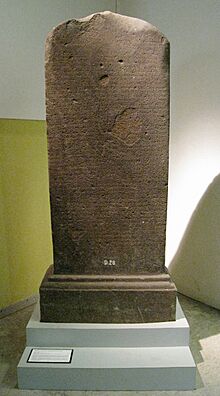Shivagrha inscription facts for kids
Quick facts for kids Shivagrha inscription |
|
|---|---|

Shivagrha inscription, displayed at National Museum of Indonesia, Jakarta
|
|
| Material | Andesite stone |
| Created | 778 Saka or 856 CE |
| Discovered | Prambanan, Yogyakarta, Indonesia |
| Present location | National Museum of Indonesia, Jakarta |
| Registration | D.28 |
The Shivagrha inscription is an important stone carving from ancient Java. It tells us a lot about the Mataram Kingdom in Central Java. This inscription was made in the year 856 CE. It was ordered by King Dyah Lokapala, also known as Rakai Kayuwangi. The inscription describes a huge temple complex dedicated to the god Shiva. This temple is now known as Prambanan temple.
Contents
What the Shivagrha Inscription Is
This special stone carving is called an inscription. It was created in the year 856 CE. This date is given using a special old Javanese way called chandrasengkala. The inscription was ordered by King Dyah Lokapala. He became king right after Rakai Pikatan finished his rule. The inscription gives a detailed description of a grand temple. This temple was built for the Hindu god Shiva. It was called Shivagrha, meaning "the House of Shiva." Today, we know this amazing temple as the Prambanan temple complex.
Building the Temple and Changing a River
The inscription talks about a big project to move a river. This river was too close to the Shivagrha Temple. The river is now known as the Opak River. It flows from north to south on the west side of Prambanan. Historians believe the river used to curve closer to the main temple.
To make more space, the river's path was changed. Workers cut a new path for the river. This new path ran along the outer wall of the temple. The old riverbed was then filled in. This created a wider area for the temple to grow. This new space was used for rows of smaller, complementary temples called pervara temples.
Kings, Queens, and Power Struggles
The inscription also shares details about the royal family. It mentions that King Pikatan was a follower of Shivaism. This is a branch of Hinduism. Interestingly, his queen, Pramodhawardhani, was a Buddhist. This shows how different religions existed side-by-side.
The inscription also talks about a fight for the throne. This battle was for royal succession. It was between King Pikatan and a rebel named Jatiningrat. The rebel had built a fortress using hundreds of stones. This fortress is believed to be at the site of Ratu Boko. For a long time, people thought Balaputradewa led this war against Pikatan. However, new ideas suggest it was likely Rakai Walaing pu Kumbayoni. Rakai Walaing was a powerful local leader. He claimed to be related to an old king of Java. He challenged King Pikatan's right to rule.
Where to See the Inscription Today
You can see the Shivagrha inscription today. It is displayed at the National Museum of Indonesia in Jakarta. Its inventory number there is D.28.
What the Inscription Tells Us
The Shivagrha inscription is very long. It has many parts that tell us about life in ancient Java. Here are some of the main things it describes:
- The King's Qualities: It praises the young prince, likely King Pikatan. It says he was righteous and brave in battles. He was also a great king who cared for his people.
- Religious Differences: It clearly states that the king was a Shaivist. This means he worshipped Shiva. But his queen was a Buddhist. This shows religious tolerance.
- The Battle for the Throne: It mentions the fight for power. A rebel built a stone fortress. This part helps historians understand the conflicts of that time.
- New King and Order: After the old king, Jatiningrat, stepped down, Dyah Lokapala became the new ruler. The inscription says the people were free.
- Funeral Ceremonies: It talks about royal orders for funeral ceremonies. It also mentions land being given to someone named Wantil.
- Building the Temple: The inscription describes the construction of the Shiva temple. It says the king built many sanctuaries. It also mentions the beauty of the temple and its surroundings.
- The River Project: It details how the river was moved. This was done to make the temple grounds safer and larger.
- Temple Lands and Rules: It describes the rice fields that belonged to the Shiva temple. These lands were given as a freehold. This means they belonged to the temple forever. It also warns people to always follow the gods' commands. If they didn't, they would face bad consequences.
- The Inauguration: The inscription records the exact date the god's statue was finished and the temple was officially opened. This was in the Saka year 778 (856 CE).
See also
- Canggal inscription (732)
- Kalasan inscription (778)
- Kelurak inscription (782)
- Karangtengah inscription (824)
- Tri Tepusan inscription (842)
- Mantyasih inscription (907)
- Hinduism in Indonesia
- Hinduism in Java
- Indonesian Esoteric Buddhism

